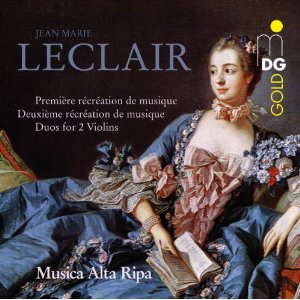 |
 |
|

Support
us financially by purchasing this disc from: |
|
|
|
|
|
Jean-Marie LECLAIR (1697
- 1764)
Récréations de musique 1 & 2
Première récréation de musique in D,
op. 6* [25:42]
Sonata for two violins in e minor, op. 3,5 [8:41]
Sonata for two violins in E, op. 12,2 [14:06]
Deuxième récréation de musique in g
minor, op. 8*/** [26:44]
 Musica Alta Ripa (Danya Segal (recorder)*, Hans-Peter Westermann
(oboe)**, Anne Röhrig, Ulla Bundies (violin), Albert Brüggen
(cello), Dennis Götte (theorbo, guitar), Bernward Lohr (harpsichord))
Musica Alta Ripa (Danya Segal (recorder)*, Hans-Peter Westermann
(oboe)**, Anne Röhrig, Ulla Bundies (violin), Albert Brüggen
(cello), Dennis Götte (theorbo, guitar), Bernward Lohr (harpsichord))
 MUSIKPRODUKTION DABRINGHAUS UND GRIMM MDG 3091762-2 [75:44]
MUSIKPRODUKTION DABRINGHAUS UND GRIMM MDG 3091762-2 [75:44]
|
|
|
Jean-Marie Leclair is a key figure in the development of French
music in the 18th century. For many years the French resisted
the influence of the Italian style. As the violin was one of
the symbols of that style it wasn't taken quite seriously. Jean-Baptiste
Lully, of Italian birth and educated as a dancer and violinist,
had introduced the instrument into the opera orchestra, but
it was the last decade of the 17th century before some instrumental
music appeared which was written specifically for the violin.
Even those pieces barely exploited the specific features of
the instrument. In 1705 a French author stated that the violin
"is not noble in France. One sees few persons of quality playing
it (...)".
Leclair was the first true violin virtuoso in France who composed
a considerable number of sonatas for his own instrument. His
style became more virtuosic after a period of study with the
Italian violinist Giovanni Battista Somis, pupil of Corelli,
in Turin. In Leclair's music we find various playing techniques
which were not used in music written by, for instance, François
Couperin. Among them are multiple stopping, tenuto effects
or arpeggios. At the same time he avoided all virtuosity for
its own sake: the main feature of his music is the balance between
the exploration of the technical abilities of the violin and
sometimes strong expression on the one hand and the elegance
and restraint which is characteristic of the French style on
the other.
This disc offers both sides of the composer's oeuvre. On the
one hand we hear two specimens from the two collections of sonatas
for two violins without basso continuo which were printed as
op. 3 and op. 12 respectively. The first appeared in 1730, the
second between 1747 and 1749. Although there are French elements
in them - both include a dance movement, a gavotte en rondeau
and a menuet respectively - they are dominated by the Italian
style. The largo from the Sonata in E, op. 12,2 has the
first violin playing a cantilena with the second violin playing
arpeggios. In these two sonatas the violins are treated on an
equal footing, imitating each other or playing in parallel.
However, there are also episodes in which the first has the
lead and the second is reduced to an accompanying role or vice
versa.
The two pieces which were printed as Récréation
de musique in 1736 and around 1737 are largely French in
orientation. In fact these are dance suites as we know them
from the 17th century. They begin with an ouverture which
is followed by dances such as forlane, gavotte, passepied
or sarabande. Each includes a chaconne, one of
the most popular forms in France. The Première récréation
ends with it, but in the Deuxième récréation
it is followed rather surprisingly by an exciting tambourin,
a folkdance which Rousseau described as "a kind of dance much
in style today in the French theatre". Its character is underlined
here by the addition of recorder and oboe to the violins. This
is one of the features of the performance of these two suites.
The first is scored for two violins, the second for violins
or transverse flutes. In his liner-notes Bernward Lohr writes
that "we have instrumented Leclair's three-part texture (...)
with the employment of a recorder and oboe and with a shifting
continuo instrumentation in order in this way to endow the precise
and sharp contrast element in his compositions with all the
greater brilliance".
The wind instruments sometimes play in alternation with the
violins but mostly colla parte. This reflects the performance
practice in the French opera orchestra of the 17th century,
and that seems fitting considering the character of the two
suites. I am not totally sure, though, whether this is in line
with Leclair's intentions, also because the recorder and the
oboe seem to play hardly any role in his oeuvre. That said,
musically speaking it works very well, and the character of
Leclair's music is effectively expressed. The récréations
are, according to the addition to their titles, easy to play.
The two sonatas are quite different and techically much more
demanding. The interpretations by Anne Röhrig and Ulla
Bundies leave nothing to be desired.
Leclair's music never disappoints, and this disc bears witness
to that. He is one of the ensemble's favourite composers, and
that shows. They play with zest and noticeable enthusiasm. Technically
these performances are excellent, and musically very engaging.
The dance rhythms in the two suites come off perfectly and many
listeners will find it impossible to keep their feet still.
This is simply wonderful stuff.
Johan van Veen
http://www.musica-dei-donum.org
https://twitter.com/johanvanveen
|
Support
us financially by purchasing this disc from:
|
|
|
|
|
|
|
|
|
|
|

